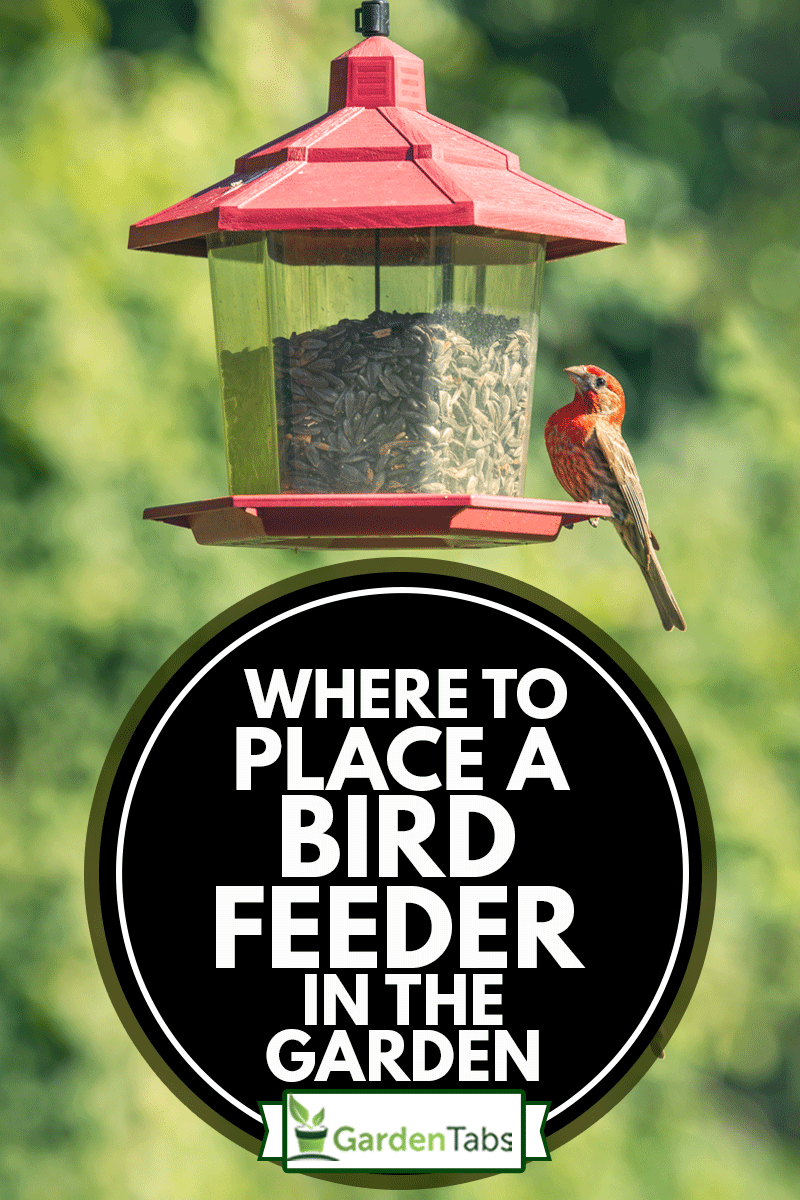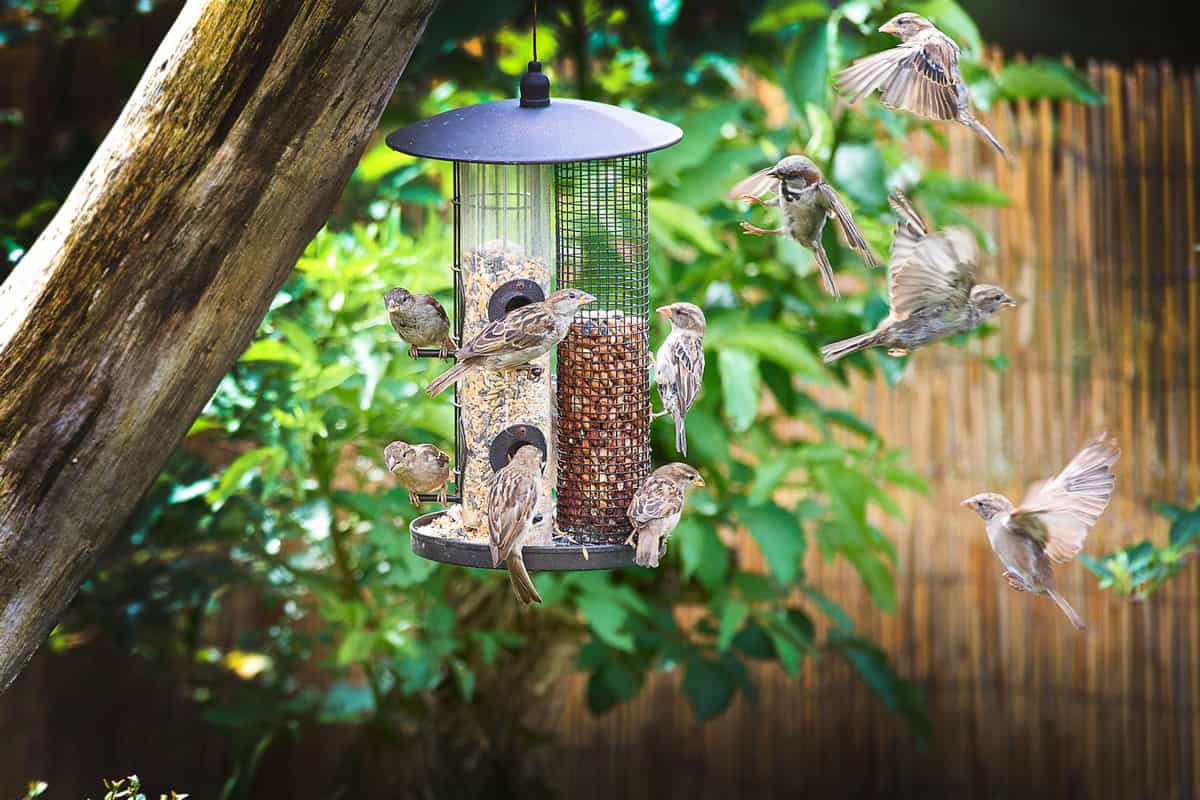Are you thinking about adding a bird feeder to your garden? Waking up to the sound of chirping birds and watching them fly around is a relaxing way to start the day. You probably want to know the best location for a bird feeder. Lucky for you, we have researched this very topic, so you know the best spots in your garden to place a bird feeder.
If you want to attract the maximum amount of birds to your yard, don't randomly place a feeder in your garden. There are several factors you should consider when deciding where to put one. Here are some key characteristics of different spots where bird feeders thrive:
- Good visibility
- Near a place of protection
- Out of direct sunlight
- Blocked from wind
- Away from predators
- Near a water source
You probably still have some questions about where to put your bird feeder. Keep reading for more tips and tricks on putting up a bird feeder in your garden.

The Best Place To Put A Bird Feeder In A Garden
Most gardens have many great locations for bird feeders. It may be difficult to find a spot that has all of the above characteristics, but don't worry; your feeder can still be popular with only a few of these features. Let's take a look at why the following characteristics are beneficial to your bird feeder location.
Good Visibility
Proper visibility is important for birds and you. Your feeder should be in an area where birds can see it. If you hide it underneath a large tree branch with thick foliage, it could take weeks for birds to find it. Once they do find it, you won't be able to see them. If you want to watch birds, then a feeder that isn't visible to you defeats the purpose of putting it up in the first place.
Before putting up your feeder, first, find a comfortable place where you plan to sit while watching the birds. This can either be outside or through a window in your home. Look for areas that both you and the birds can clearly see. If the birds can find it, they will come for food, and you will have plenty of wildlife to observe.
How Far From The House Should A Bird Feeder Be?

The farther away a bird feeder is from your house, the better. A distance of at least 50 to 60 feet is recommended. However, you can place bird feeders as close as 3 feet from your home.
Keep in mind a feeder this close to your home may attract other critters. Squirrels, mice, raccoons, and even rats are known to eat out of bird feeders. The closer a feeder is to your home, the closer these animals may come to your home too.
If you are concerned about pests entering your garden and eating your petunias, check out this post: What Is Eating My Petunias?
Also, a bird feeder right next to a door or window can be a hazard to the bird. If there is food attracting them close, they are more likely to fly into the glass and hurt themselves. To keep your home and the birds safe, put your feeder at least 50 feet from your home.
Here is a handy tool to help keep squirrels out of a mounted bird feeder. This wrap-around baffle goes underneath the feeder to prevent squirrels from climbing up the pole. It is very easy to install and easily protects your bird food.
Click here to view it on Amazon.
Near A Place Of Protection
Another great location for a bird feeder is near a bush, tree, or any other natural shelter. These places serve as a sanctuary of protection for birds. Ten feet away from these places is a good distance to install your bird feeder. This much space allows birds to quickly dart to the natural shelter if they feel threatened. They can also wait their turn to feed in these places of protection. When birds feel safe, they are more likely to use your feeder, so you will see them more.
Away From Direct Sunlight
Birds like sun, but too much direct sunlight shining on your bird feeder may keep them from using it. The landing surfaces get very hot if they are exposed to long stretches of intense sunlight. Also, some bird food germinates if it gets hot enough and there is enough moisture in the air. If you can, it is always better to place bird feeders in areas with indirect sunlight or morning/afternoon sun only.
Do Birds Like Feeders In Sun or Shade?
You can place bird feeders in both sunny and shady spots. Most birds prefer feeders to have some sun and some shade. Feeders are easier to see in sunny spots, so a bird feeder here will receive more visitors.
However, as mentioned above, you should not put the feeder in areas that receive long hours of intense direct sun. You should also no put feeders in areas with no sun. This can attract pests, like Japanese beetles, and encourage mold growth inside the feeder. The best solution is to put your bird feeder in an area that is both sunny and shady at different parts of the day.
If you find Japanese beetles in your garden or near your bird feeder, check out this post: How To Get Rid Of Japanese Beetles [An Exploration Of 8 Methods]
Blocked From Direct Wind
It is also beneficial to find a spot with a natural wind block. If you place your feeder in a windy area, it will move around, and the feed will fall out. In addition, it will be more difficult for the birds to land on the feeder to eat. A safe distance away from a large tree is a great option. It can double as a wind block for the feeder and a shelter for the birds.
Away From Predators

Make sure to place your bird feeder away from areas where predators, like cats and raccoons, can reach. Don't put your feeder close to low-hanging cables or fences. Cats can easily climb a fence and jump on a bird feeder while a bird is eating. Squirrels can easily climb along low-hanging cables to steal the bird food and scare birds away.
Near A Water Source
If you have a small pond or a birdbath in your garden already, then putting a bird feeder close is an excellent option. Birds can get their food and drink in one easy location when a feeder is near a water source.
Here is a lightweight birdbath you could put in your garden along with your bird feeder.
Click here to view it on Amazon.
Will A Bird Feeder Keep Birds Out Of My Garden?
Yes, a bird feeder helps keeps birds out of your garden. By installing a feeder, you are providing an easy-to-access food source. Most birds will choose bird feed over plants in your garden when given the choice.
If your garden has been ruined by birds, and you want to fill your garden with new plants, check out this post: 11 Edible Plants That Grow Fast [Healthy & Yummy!]
How Do You Hang A Bird Feeder If You Don't Have A Tree?
If you do not have a tree in your garden, you can use a bird feeder pole to hang your feeder. There are many different pole kits available. They vary in features and heights, so you have plenty of options to choose from.
This is an entire bird feeding station. It has multiple hooks, so you can hang more than one bird feeder. It's an excellent option if you don't have trees in your garden.
Click here to view it on Amazon.
How Long Does It Take For Birds To Find A New Bird Feeder?

There is no standard time frame for when birds find new feeders. Sometimes birds will find a new feeder within 1 to 2 days. Other times, it can take weeks. If you haven't noticed any birds at your feeder for a month, you might want to change its location to a more suitable spot.
Can You Put A Hummingbird Feeder Next To A Bird Feeder?
It is not recommended to put a hummingbird feeder close to a bird feeder. Hummingbirds are very small, and other birds sometimes frighten them. These larger birds may also use the hummingbird feeder to perch, which blocks their access to food. If you want to keep those hummingbirds buzzing around, make sure to leave at least 20 to 30 feet between feeders.




It’s great that you mentioned how there are several factors you should consider when deciding where to put a bird feeder. My wife likes birdwatching, so I am thinking of installing a bird feeder on our property. But first, I need to buy some outdoor bird feeders online.